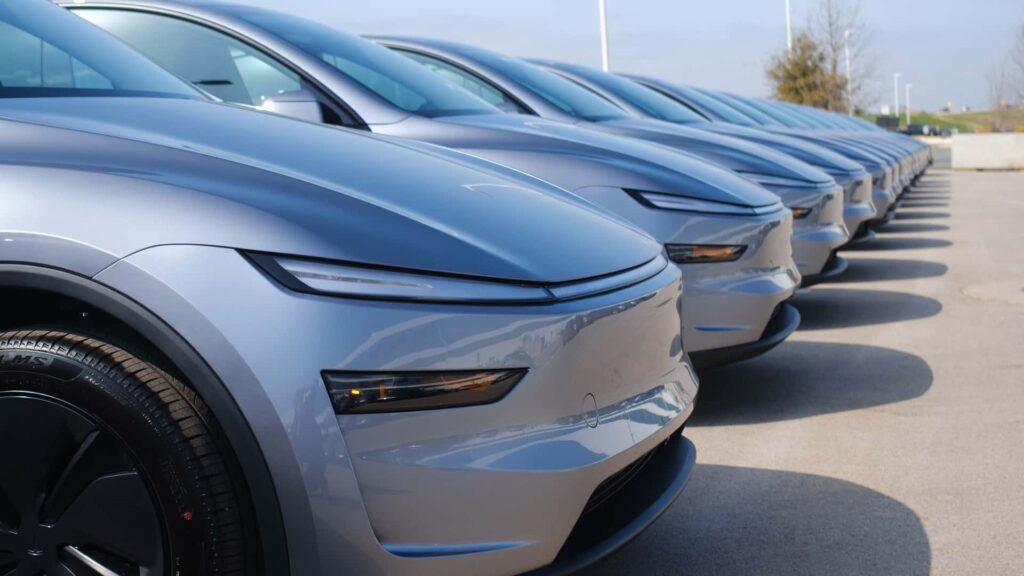- Tesla reported its second-quarter vehicle deliveries on Wednesday.
- The EV maker said it delivered 384,122 cars globally from April through June.
- Tesla’s future rests on the lower-cost new models it’s working on.
After struggling with sagging sales for over a year, Tesla failed to turn things around in the second quarter. It’s more bad news for the automaker and for the American EV market, of which Tesla still makes up a huge but shrinking share.
On Wednesday, Tesla said it delivered 384,122 vehicles globally in Q2, a 13% drop year-over-year. Tesla sold 373,835 Model Y crossovers and Model 3 sedans, along with just 13,409 “Other Models.” That category includes the Cybertruck pickup, Model S sedan and Model X three-row SUV.
Tesla’s biggest cheerleaders—CEO Elon Musk included—envision it as an AI and robotics company. The longtime promise that Tesla will deploy millions of self-driving cars has boosted its market cap to $1 trillion, significantly more than any car company on the planet. But the reality is that Tesla makes nearly all of its money the way any other carmaker does: by selling cars. And that business hasn’t been doing so hot lately.
The lackluster Q2 follows a similar decline in Q1, when deliveries fell 13% year-on-year and Tesla’s had its worst quarter in over two years. It caps off a rough 18 months for the electric automaker. In 2024, Tesla’s sales flatlined for the first time in over a decade. It sold 1.79 million vehicles globally that year, slightly less than 2023’s 1.81 million.
Before that, the automaker saw years of exploding sales and more than enough demand. Tesla delivered 499,550 vehicles in 2020, 936,172 in 2021 and 1.3 million in 2022.
Photo by: Tim Levin/InsideEVs
Why Are Tesla Sales Dropping?
The big question for months now has been whether or not Tesla’s facelifted Model Y—its cash cow—could turn sales around and counteract the numerous headwinds the automaker is facing. Those include its CEO’s controversial politics, an aging vehicle lineup that lacks a cheaper model, increased hesitancy among EV buyers and the flop that is the Cybertruck.
Tesla blamed its poor first-quarter sales on the new model, which had just been introduced and was being ramped up at factories around the globe.
A few months later, it doesn’t look like the new Model Y has been Tesla’s saving grace. The automaker doesn’t break out deliveries by model or region, so we won’t know how exactly the Model Y did until we see some third-party analysis.

The Tesla Cybertruck hasn’t helped lift Tesla’s sales.
Photo by: InsideEVs
Preliminary estimates from Cox Automotive indicate that Tesla’s sales in the U.S. specifically plummeted by 20% in Q2, as compared to the same period last year. That drove a 6% drop in overall U.S. EV sales, Cox says.
Tesla Faces A Tough Year Ahead
After a tough year and a half, Tesla isn’t out of the woods. It’s unclear whether the brand will ever recover from the reputational damage inflicted by Musk’s role in the Department of Government Efficiency.
And on top of that, major policy changes at the federal level threaten to stunt the EV transition in this country. The Senate just passed the “One Big Beautiful Bill Act,” which kills off longstanding tax credits for used, new and leased electric cars. The federal government is taking aim at funding for EV charging infrastructure. And it aims to roll back vehicle efficiency regulations that benefit Tesla by incentivizing other carmakers to buy its lucrative regulatory credits.
Unlike Ford, General Motors and the other legacy automakers, Tesla can’t fall back on sales of gas-powered vehicles if EV demand slows down further. And that’s exactly what numerous analyses expect to happen once the Trump administration and Congress get their way.
Wall Street analysts expect Tesla’s sales to drop again in 2025. But the extent to which that happens depends heavily on Tesla’s next car—or, maybe, cars.
The EV maker has said for months that it plans to roll out mysterious “more affordable models” starting in the first half of 2025. The EV market in America is in dire need of cheaper, long-range, aspirational cars. If Tesla can deliver something truly compelling, that could go a long way toward digging it out of this sticky situation.
Contact the author: Tim.Levin@InsideEVs.com
Additional material from Patrick George
